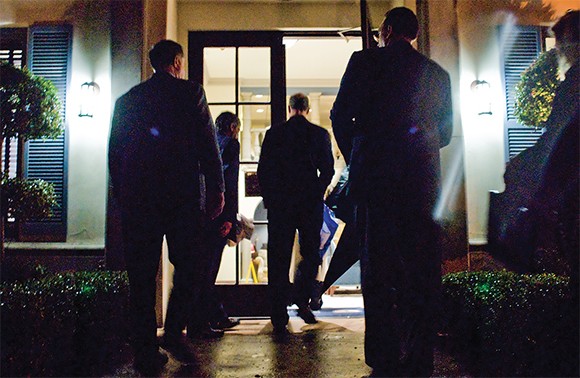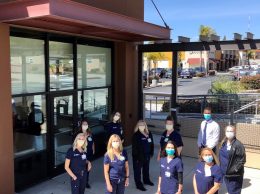
Federal regulators and employees of First California Financial Group file into San Luis Trust
Bank just before the seizure of San Luis Trust was announced. (Stephen Nellis / Business Times photo)
At 5:45 p.m. on Feb. 18, a rainy Friday evening, C.G. Kum sat sipping coffee in a Starbucks in San Luis Obispo, flanked by a team of men and women in black suits.
At 6 p.m., the First California Financial Group CEO put his cup down, stood up, straightened his trench coat and walked out the door. His entourage followed and marched one block up the street, to an intersection where a team of federal banking regulators was waiting.
Kum’s team and the regulators swarmed inside the only branch of San Luis Trust Bank. It was the third tri-county banking failure of the financial crisis.
‘Critical’ cash shortage
San Luis Trust had failed to meet regulators’ capital requirements for more than a year, and was taken into receivership by the Federal Deposit Insurance Corp on Feb. 18. The FDIC shut the bank down shortly after closing time and started to transfer the assets to First California, a Westlake Village-based banking company.
First California assumed San Luis Trust’s one branch, in downtown San Luis Obispo, along with its $332.6 million in assets and $272.2 million in deposits. It entered into what’s called a “loss-share agreement” with the FDIC on $241.7 million of San Luis Trust’s assets, which protects First California from the full sting of losses related to the acquisition.
A team of about 60 FDIC staff members worked late into the night and through the weekend to wind San Luis Trust down and transfer its assets to First California.
San Luis Obispo-based San Luis Trust Bank was “critically undercapitalized,” the federal Office of Thrift Supervision said in its final warning to the bank on Feb. 9.
The bank was “heavily invested in real estate,” FDIC spokeswoman Barbara Brunson, who was at the bank the night of the failure, told the Business Times.
The FDIC suffered a $96.1 million loss to its deposit insurance fund as a result of the failure. The agency guarantees all deposits up to $250,000.
San Luis Trust was the sixth-largest banking company based in the Tri-Counties, with $333 million in assets at the end of 2010. It struggled with large losses — $13 million in 2010 and $5.4 million in 2009 — and regulators rejected its latest capital restoration plan rejected.
Unable to raise capital, the bank was issued a final warning on Feb. 9, giving it just six days to complete a capital raise, merge or be acquired – or be shut down.
San Luis Trust’s relatively small size and reliance on brokered deposits means it didn’t have much core franchise value, three knowledgeable San Luis Obispo bankers told the Business Times after San Luis Trust received its final warning. The bankers didn’t want to be quoted for attribution.
Regulators are often wary of brokered deposits, which come from brokers who put their clients’ money into whatever bank promises the best return, because they are not as reliable as other deposits.
First California, meanwhile, completed a $39 million capital raise in 2010. Kum told the Business Times last year that a significant portion of the proceeds from the raise were earmarked for troubled bank assets, and in November it acquired a failed Woodland Hills bank. “If the circumstances are appropriate we’ll move forward with more such acquisitions,” Kum said then.
New territory
As his team opened its briefcases and settled in for the evening inside the San Luis Trust branch, Kum stepped out into the rain to talk to reporters. The FDIC-assisted deal was “very lucrative” for his bank, he said, and San Luis Trust represents “a tremendous asset.” He wouldn’t discuss the terms in detail but said the deal gives First California its 19th branch and its first foray into the Central Coast market, bringing it to about $1.9 billion in assets.
Kum said he plans to hire a regional president with experience in the San Luis Obispo banking industry to run the new branch. He wouldn’t say yet who that might be, but hinted that it could be a familiar face on the Central Coast banking scene.
San Luis Trust President Bradley Lyon did not return Business Times calls seeking his comments prior to the seizure.
San Luis Trust is the third bank in the Tri-Counties to be shut down by regulators in the past two years, after Affinity Bank, which failed in August 2009, and Los Padres Bank, which failed in August 2010. Both of those banks were acquired by San Diego-based Pacific Western Bank.
There are a handful of other tri-county institutions with loan problems or capital weaknesses, but the most recent takeover signals that the banking crisis on the Central Coast has reached a final chapter, industry insiders told the Business Times in the run-up to the San Luis Trust failure.






 Print
Print Email
Email

















